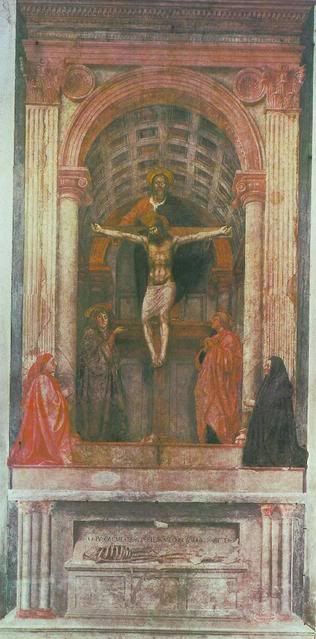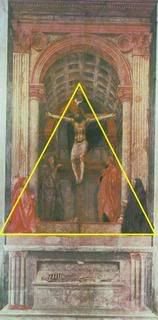I fully intended to post yesterday, in honor of Ash Wednesday, but when I got to work (where I write most entries) my boss gave me something stupid to do, so alas, it was pushed off a day. Since it's the beginning of Lent, I wanted to do something of a religious nature. Flipping through an old Art History notebook, nothing struck me as overly Lent-y, so I chose a really cool fresco to talk about.
Trinity Fresco, Masaccio, sometime between 1425 and 1428
Fun Fact- Many artists during the Renaissance only went by one name (Giotto, Donatello, Raphael, etc.). Sometimes the name they commonly went by was a nickname, or a diminutive form of their real name. Masaccio's real name was Tommaso Cassai, but the name "masaccio" basically means "big, ugly, clumsy Tom." This was to distinguish him from one of his peers, who was also named Tommaso, and whom we know as Masolino (little delicate Tom). It's kind of like on one of my soccer teams growing up, we had a "Big Megan" and a "Little Megan" because two Megans on one field is too many.
This fresco is in Santa Maria Novella, in Florence (and if I was studying abroad in Florence right now, I would certainly make a point of visiting Sta. Maria Novella because there's lots of cool stuff in there *ahem*Allie*ahem*). It is on the wall, and meant to look like another chapel because it has the illusion of receding into space. Masaccio was one of the first artists to use linear perspective, which is responsible for this illusion, and we can see evidence of it if you look at the vaulting on the pretend ceiling. If you were to extend those lines, they would all converge at a "vanishing point." In this case, our vanishing point would be somewhere right around Christ's knees.
Another big thing during the Italian Renaissance was the pyramidal structure. Artists tended to structure their paintings in a triangular shape for two reasons (that I can think of off the top of my head): a triangular structure would make for a balanced composition, and balance is aesthetically pleasing, and the triangle is related to the trinity, so it would elevate the "holiness" of the work, or at least reflect the subject matter in its form. The pyramidal structure is definitely at work here. If you connect all the people you have a nice, almost equilateral, triangle.
Let's talk about imagery. Obviously, the guy on the cross would be Jesus Christ. The old guy behind him is God the Father. Artists back then were a lot less hinky about painting images of God, and the old bearded guy with a halo is usually what they went with to depict him. The white thing on God's robe isn't a collar, but a dove, which symbolizes the Holy Spirit. So we have the Father, Son, and the Holy Spirit- the whole Trinity, hence the name of the fresco. Underneath Christ is the Virgin Mary on our left, and St. John the Baptist, on our right. The remaining two figures, outside of the fake chapel, or you could say in the viewer's space ("the real world" and out of the holy area) are two members of the Lenzi family. They commissioned Masaccio to paint this fresco, and back then it was not at all uncommon for the patrons of a piece of work to be included in it. Having your portrait associated with an image like this would 1) show how devout you are, and 2) show how wealthy you are; both of which were good things to be in 15th century Florence.
I could talk about how the architecture is classical, but I think that's probably the least interesting part of this fresco.
Here's the most interesting part: Up until 1861, the whole bottom part, underneath the step which the images of the patrons are kneeling on, was behind a stone altar and altarpiece made by Vasari. Then one day someone decided to move it (well, probably a bunch of someones, as I would imagine a stone altar would be pretty heavy), and they found this awesome, creepy part of the work that no one even knew was there! It's a sarcophagus with a skeleton inside it and an inscription that (according to Wikipedia) reads "I Was What You Are And What I Am You Shall Be." Awesome and creepy, right? Apparently it's some kind of ancient warning, but I'm not really sure what that means. The sentiment is familiar, but I've never heard that phrase before; then again, I'm not really up on my ancient warnings. One interpretation is that the skeleton is Adam's skeleton. Another take is that it's a journey to salvation. You start and end as corporeal matter, but with prayer (demonstrated by the patron portraits), and intercession (of the Virgin and Saints), you can make your way up to the Trinity and join the Kingdom of Heaven.
Another way to think of the Stairway to Heaven- baby steps toward eternal salvation.
Subscribe to:
Post Comments (Atom)



Speaking of Lent - don't you think that "ancient warning" is somewhat simallar to the whole "From dust you came and to dust you shall return" bit you hear when you received your ashes....well, let's ask Katie since she is the only one of us practicing these days....but that's what your ancient warning sounds like to me! What do you think, Miss Smarty pants?
ReplyDeleteYeah, it generally implies that we're all going to die someday. A memento mori, if you want the fancy latin term.
ReplyDeleteAnd by the way, the don't say that when you're getting ashes anymore. They thought it was too scary and no say something like "Repent and you shall be forgiven," or something like that.